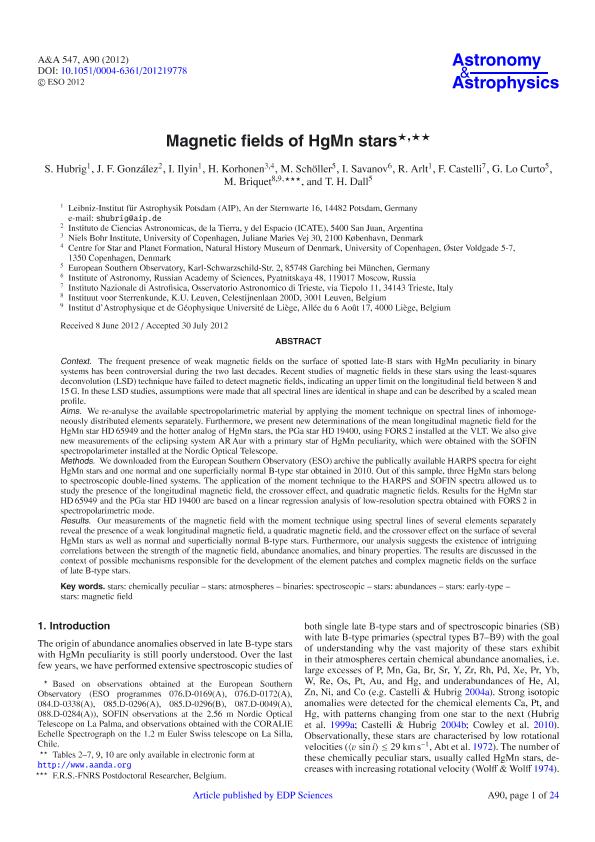Mostrar el registro sencillo del ítem
dc.contributor.author
Hubrig, S.
dc.contributor.author
Gonzalez, Jorge Federico

dc.contributor.author
Ilyin, I.

dc.contributor.author
Korhonen, H.
dc.contributor.author
Schöller, M.
dc.contributor.author
Savanov, I.
dc.contributor.author
Arlt, R.
dc.contributor.author
Castelli, F.
dc.contributor.author
Lo Curto, G.
dc.contributor.author
Briquet, M.
dc.contributor.author
Dall, T. H.
dc.date.available
2019-02-01T18:57:54Z
dc.date.issued
2012-11
dc.identifier.citation
Hubrig, S.; Gonzalez, Jorge Federico; Ilyin, I.; Korhonen, H.; Schöller, M.; et al.; Magnetic fields of HgMn stars; EDP Sciences; Astronomy and Astrophysics; 547; 11-2012; 1-24; A90
dc.identifier.issn
0004-6361
dc.identifier.uri
http://hdl.handle.net/11336/69211
dc.description.abstract
Context. The frequent presence of weak magnetic fields on the surface of spotted late-B stars with HgMn peculiarity in binary systems has been controversial during the two last decades. Recent studies of magnetic fields in these stars using the least-squares deconvolution (LSD) technique have failed to detect magnetic fields, indicating an upper limit on the longitudinal field between 8 and 15 G. In these LSD studies, assumptions were made that all spectral lines are identical in shape and can be described by a scaled mean profile. Aims. We re-analyse the available spectropolarimetric material by applying the moment technique on spectral lines of inhomogeneously distributed elements separately. Furthermore, we present new determinations of the mean longitudinal magnetic field for the HgMn star HD 65949 and the hotter analog of HgMn stars, the PGa star HD 19400, using FORS 2 installed at the VLT. We also give new measurements of the eclipsing system AR Aur with a primary star of HgMn peculiarity, which were obtained with the SOFIN spectropolarimeter installed at the Nordic Optical Telescope. Methods. We downloaded from the European Southern Observatory (ESO) archive the publically available HARPS spectra for eight HgMn stars and one normal and one superficially normal B-type star obtained in 2010. Out of this sample, three HgMn stars belong to spectroscopic double-lined systems. The application of the moment technique to the HARPS and SOFIN spectra allowed us to study the presence of the longitudinal magnetic field, the crossover effect, and quadratic magnetic fields. Results for the HgMn star HD 65949 and the PGa star HD 19400 are based on a linear regression analysis of low-resolution spectra obtained with FORS 2 in spectropolarimetric mode. Results. Our measurements of the magnetic field with the moment technique using spectral lines of several elements separately reveal the presence of a weak longitudinal magnetic field, a quadratic magnetic field, and the crossover effect on the surface of several HgMn stars as well as normal and superficially normal B-type stars. Furthermore, our analysis suggests the existence of intriguing correlations between the strength of the magnetic field, abundance anomalies, and binary properties. The results are discussed in the context of possible mechanisms responsible for the development of the element patches and complex magnetic fields on the surface of late B-type stars.
dc.format
application/pdf
dc.language.iso
eng
dc.publisher
EDP Sciences

dc.rights
info:eu-repo/semantics/openAccess
dc.rights.uri
https://creativecommons.org/licenses/by-nc-sa/2.5/ar/
dc.subject
Binaries: Spectroscopic
dc.subject
Stars: Abundances
dc.subject
Stars: Atmospheres
dc.subject
Stars: Chemically Peculiar
dc.subject
Stars: Early-Type
dc.subject
Stars: Magnetic Field
dc.subject.classification
Astronomía

dc.subject.classification
Ciencias Físicas

dc.subject.classification
CIENCIAS NATURALES Y EXACTAS

dc.title
Magnetic fields of HgMn stars
dc.type
info:eu-repo/semantics/article
dc.type
info:ar-repo/semantics/artículo
dc.type
info:eu-repo/semantics/publishedVersion
dc.date.updated
2019-01-31T14:02:41Z
dc.journal.volume
547
dc.journal.pagination
1-24; A90
dc.journal.pais
Francia

dc.journal.ciudad
Paris
dc.description.fil
Fil: Hubrig, S.. Leibniz Institut für Astrophysik Potsdam ; Alemania
dc.description.fil
Fil: Gonzalez, Jorge Federico. Consejo Nacional de Investigaciones Científicas y Técnicas. Centro Científico Tecnológico Conicet - San Juan. Instituto de Ciencias Astronómicas, de la Tierra y del Espacio. Universidad Nacional de San Juan. Instituto de Ciencias Astronómicas, de la Tierra y del Espacio; Argentina
dc.description.fil
Fil: Ilyin, I.. Leibniz Institut für Astrophysik Potsdam ; Alemania
dc.description.fil
Fil: Korhonen, H.. Universidad de Copenhagen; Dinamarca. Natural History Museum of Copenhague; Dinamarca
dc.description.fil
Fil: Schöller, M.. European Southern Observatory; Alemania
dc.description.fil
Fil: Savanov, I.. Russian Academy of Sciences; Rusia
dc.description.fil
Fil: Arlt, R.. Leibniz Institut für Astrophysik Potsdam ; Alemania
dc.description.fil
Fil: Castelli, F.. Istituto Nazionale di Astrofisica; Italia
dc.description.fil
Fil: Lo Curto, G.. European Southern Observatory; Alemania
dc.description.fil
Fil: Briquet, M.. Katholikie Universiteit Leuven; Bélgica. Université de Liège; Bélgica
dc.description.fil
Fil: Dall, T. H.. European Southern Observatory; Alemania
dc.journal.title
Astronomy and Astrophysics

dc.relation.alternativeid
info:eu-repo/semantics/altIdentifier/doi/http://dx.doi.org/10.1051/0004-6361/201219778
dc.relation.alternativeid
info:eu-repo/semantics/altIdentifier/url/https://www.aanda.org/articles/aa/abs/2012/11/aa19778-12/aa19778-12.html
Archivos asociados
